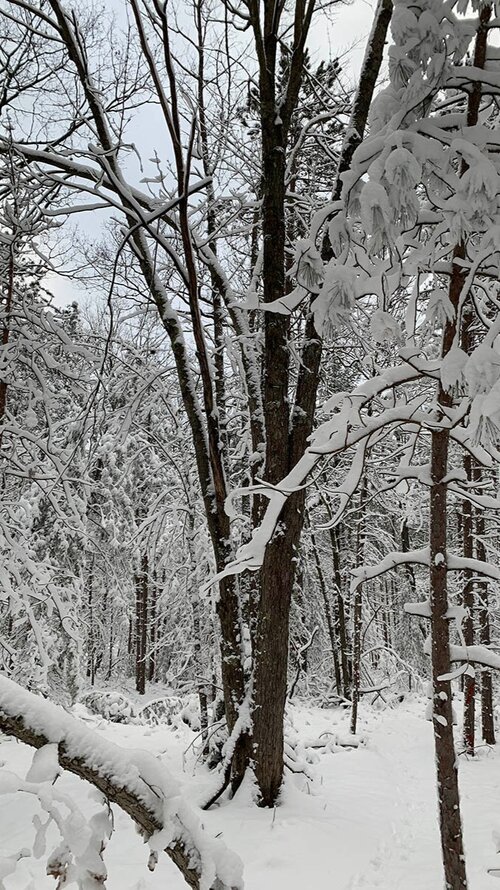On December 12, 2020 Northwest Lower Michigan experienced its first winter storm of the season. And combined with holiday lights and a wood-burning fireplace, it made for some spectacularly festive views. Blu, our 19-month-old Vizsla especially enjoyed a return to smashing through snowdrifts.
But imagine if you were a tree in the woods, rooted in place and dealing with this onslaught.
Individually, each snowflake is manageable. During the course of the storm, there are millions that float by in their seemingly innocuous trajectory. However for those that land, the weight becomes less and less manageable until ultimately, the tree is bent almost beyond recognition. Some snap under the strain.
But wait - aren’t all trees able to handle this? What is it that assures some survive? The answer lies in their design.
Some deciduous trees have shed their leaves, once useful for photosynthesis; but in a snowstorm they become a liability. Many trees invest in multiple trunks using different angles to share the burden of feeding the main body. Similarly, coniferous trees with a solid base seem to manage the additional weight more easily.
In the middle of a forest, however, some trees put all their energy into one primary trunk as they seek sunlight in competition with taller trees. They hold their leaves longer to maximize their investment as more sunlight becomes available later in the year. And as they invest in concentrations of leaves or needles at higher altitudes, they sacrifice the necessary balance of a strong, stable base.
Okay, so all these hiker’s observations may be interesting (or not), but how do they relate to wayfinding?

Wayfinding’s “Winter Storm Effect”
Think of your staff: the hardworking caregivers circulating through the halls everyday, posted at unit desks or in offices close to public circulation. Much like the tree in the middle of the woods, they are rooted to their units, their routines. They see people “float by in their seemingly innocuous trajectory.” However for those that “land,” those in need of help, the weight of distraction, interruption and personal escort become less and less manageable.
But wait - aren’t healthcare cultures and facilities meant to handle this? What is it that assures that some survive? The answer, again, lies in their design.
Yes, you have a policy to greet everyone with eye contact, a warm smile and an offer to help if needed. But the combined “weight” of these interventions may eventually cause your culture to snap. Mitigate this by designing a system of proactive wayfinding elements so guests are empowered rather than asking for help.
- The problem of a single trunk
- Relying on the elusive “silver bullet” to solve wayfinding challenges, whether you’ve been sold a digital platform or physical signage, negates other potential means of navigating for those who will ultimately need help.
- Updating tools is always a challenge in healthcare cultures, though we know that almost as soon as they’re launched they can be outdated. Using several platforms, managed by multiple departments only exacerbates the disconnects - for staff and patients.
- Like the trees that invest in multiple trunks at multiple angles from a single starting point, we can help design a system that diversifies the burden of communication (print, digital, verbal, training and the built environment) to better support your organization’s wayfinding culture.
- The problem of hanging onto leaves
- You may find you’ve invested a lot of money in those tools, and “by God you’re going to get your money’s worth.”
- But anyone who studies complex communication systems knows that it takes multiple efforts, at multiple levels, to maintain the health of those systems. Learning and adapting must be part of the process.
- An early focus on a human-centered approach to assessment can help you avoid investments that come at too high a cost: both financially and for your patient/staff experience reputation.
- The problem of imbalance
- Often the burden of sharing wayfinding information falls disproportionately on those who are least equipped to manage it: volunteers, busy nurse practitioners, even contract staff in coffee stands or parking garages.
- Those in decision-making roles may fail to see this burden, since their experience of the problem is less evident. They may ultimately see it reflected in lower HCAHPS scores, but by then it’s too late.
- Like the balanced conifer, build a strong base of wayfinding communication by training everyone: staff, volunteers and contractors to consistently reference integrated tools in a multi-pronged approach to communicating concisely and correctly. And share the knowledge with patients and families throughout their journey.



The time to prepare is now.
With the widespread release of vaccines, we can look toward a day where COVID-19, with its visitor restrictions, won’t be as much of a barrier to human interaction. Eventually that “snowstorm” of patients, family members, new residents, vendors and others will return to the physical and virtual hallways of your institution: each with their own trajectory. The time to prepare for this eventuality is now. Like the trees with multiple trunks, willing to shed their old leaves or designed with a solid base, your culture, people and facilities will be better able to manage the inevitable - by design.
These challenges are magnified with the pandemic-related loss of staff and the inability of many healthcare cultures to maintain a strong financial base. Early investments in proactive wayfinding design can ease this burden. Like a successful tree, starting from a strong strategic base, making smaller, more diverse investments and maintaining daily discipline while adapting, learning and branching out - a flexible wayfinding approach will result in positive outcomes for months and years to come.
No matter what storms arise.


